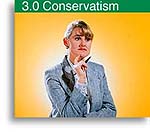
|


Scientologists have practiced their religion in Canada since the early 1950s. Almost half a century later, with the Church of Scientology and individual parishioners playing vital roles in many aspects of society and the religious community, we are still often asked, “What is Scientology?”
As part of a broad public information effort to respond to this interest, we published the 800-page What is Scientology?, the most comprehensive and authoritative text on the subject ever compiled.
What is Scientology? is available at most public libraries, and can also be viewed on the World Wide Web at www.scientology.org. The book is also for sale in hard- and soft-cover editions, and complimentary copies are available to religious leaders, government officials and members of the news media by writing to the address on the back page of this edition of Freedom.
We are also including chapters from the book as a series of articles in Freedom. In the last issue, we presented the part of Chapter 4, “A Description of Scientology.” Copies of that edition of Freedom are available free upon request.
The extract below is the completion of Chapter 4.
 Scientology is a twentieth-century religion. It comprises a vast body of knowledge extending from certain fundamental truths, and prime among those truths: Man is a spiritual being endowed with abilities well beyond those which he normally envisages. He is not only able to solve his own problems, accomplish his goals and gain lasting happiness, but also to achieve new states of awareness he may never have dreamed possible.
Scientology is a twentieth-century religion. It comprises a vast body of knowledge extending from certain fundamental truths, and prime among those truths: Man is a spiritual being endowed with abilities well beyond those which he normally envisages. He is not only able to solve his own problems, accomplish his goals and gain lasting happiness, but also to achieve new states of awareness he may never have dreamed possible.
In one form or another, all great religions have held the hope of spiritual freedom—a condition free of material limitations and misery. The question has always been, however, how does one reach such a state, particularly while still living amidst a frantic and often overwhelming society?
Although modern life seems to pose an infinitely complex array of problems, Scientology maintains that the solutions to those problems are basically simple and within every man’s reach. Difficulties with communication and interpersonal relationships, nagging insecurities, self-doubt and despair—each man innately possesses the potential to be free of these and many other concerns.
The Tone Scale
One tool drawn from the body of Scientology and commonly used in everyday life is the Tone Scale. Codified from many, many hours of exhaustive testing and observation, the Tone Scale plots emotions in an exact ascending or descending sequence. Until Mr. Hubbard’s examination of this matter, emotions were something we all suffered or enjoyed, but never fully understood.
Have you ever attempted to raise the spirits of someone mourning a recent loss with a cheerful word? The response is usually a fresh outpouring of tears.
Or someone whose outlook and response to life is a chronic apathy, no matter what is happening around him? The person seems to be in good health, has a loving family and an enviable job, but nothing makes any difference. The person just isn’t interested.
The Tone Scale precisely illuminates what is occurring with individuals such as these, how best to communicate with them and how to help them.
When a man is chronically sad about his losses, he is in grief. And, once again, behaves in a predictable manner. This is 0.5 on the chart.
When a person is not yet so low as grief but realizes losses are impending, or is fixed chronically at this level by past losses, he is in fear, around 1.0 on the chart.
Just above fear, past or impending losses generate hatred in the person. However, he dare not express this as such, so the hatred comes forth covertly. This is 1.1, covert hostility.
An individual fighting against threatened losses is in anger and manifests predictable aspects of behaviour. This is 1.5.
The person who is merely suspicious that loss may take place, or who has become fixed at this level, is resentful. He is in antagonism, which is 2.0 on the chart.









 Above antagonism, the situation of a person is not good enough from him to be enthusiastic, not bad enough for him to be resentful. He has lost some goals and cannot immediately locate others. He is said to be in boredom, or at 2.5 on the Tone Scale chart.
At 3.0 on the chart, a person has a conservative, cautious aspect toward life, but is reaching his goals.
At 4.0 the individual is enthusiastic, happy and vital.
Very few people are naturally at 4.0 on the Tone Scale. A charitable average is probably around 2.8.
This scale has a chronic or an acute aspect. A person can be brought down the Tone Scale to a low level for ten minutes and then go back up, or he can be brought down for ten years and not go back up.
A man who has suffered too many losses, too much pain, tends to become fixed at some lower level of the scale and, with only slight fluctuations, stays there. Then his general and common behaviour will be at that level of the Tone Scale.
The simplest thing to know about this scale is that people find it difficult to respond to communication which is too far above where they are stuck. If you try to help someone in apathy by talking to them in enthusiasm, you will probably not have much success. The gap between such extremes is not easily bridged unless you understand the Tone Scale.
Using knowledge of the Tone Scale, however, you would recognize the emotion one-half to one full tone above the person, communicate in that tone and thus bring him up to higher tones. By moving up the scale gradiently it is possible to help someone overcome fixed conditions and regain a more happy and vital outlook.
The Tone Scale is of enormous value in life and its relationships. Mr. Hubbard thoroughly researched human behaviour and the full body of his work in this area furnishes an accurate description of the attitudes and behaviour of others. By knowing where a person falls on the scale, one can precisely predict his actions. Knowledge of the Tone Scale gives one a greater understanding of his fellows than ever before available.
Above antagonism, the situation of a person is not good enough from him to be enthusiastic, not bad enough for him to be resentful. He has lost some goals and cannot immediately locate others. He is said to be in boredom, or at 2.5 on the Tone Scale chart.
At 3.0 on the chart, a person has a conservative, cautious aspect toward life, but is reaching his goals.
At 4.0 the individual is enthusiastic, happy and vital.
Very few people are naturally at 4.0 on the Tone Scale. A charitable average is probably around 2.8.
This scale has a chronic or an acute aspect. A person can be brought down the Tone Scale to a low level for ten minutes and then go back up, or he can be brought down for ten years and not go back up.
A man who has suffered too many losses, too much pain, tends to become fixed at some lower level of the scale and, with only slight fluctuations, stays there. Then his general and common behaviour will be at that level of the Tone Scale.
The simplest thing to know about this scale is that people find it difficult to respond to communication which is too far above where they are stuck. If you try to help someone in apathy by talking to them in enthusiasm, you will probably not have much success. The gap between such extremes is not easily bridged unless you understand the Tone Scale.
Using knowledge of the Tone Scale, however, you would recognize the emotion one-half to one full tone above the person, communicate in that tone and thus bring him up to higher tones. By moving up the scale gradiently it is possible to help someone overcome fixed conditions and regain a more happy and vital outlook.
The Tone Scale is of enormous value in life and its relationships. Mr. Hubbard thoroughly researched human behaviour and the full body of his work in this area furnishes an accurate description of the attitudes and behaviour of others. By knowing where a person falls on the scale, one can precisely predict his actions. Knowledge of the Tone Scale gives one a greater understanding of his fellows than ever before available.
|

|

